
DOWNLOAD
DATE
Contact
AI is reshaping the commercial landscape for telecom companies. It offers innovative solutions that empower telcos to operate with heightened efficiency and precision. In this Viewpoint, we explore how leveraging AI optimizes individual transactions, can boost customer engagement by over 15%, and reduce operational costs by up to 30%. As telcos embrace AI-driven tools, the potential to accelerate growth and gain a competitive advantage becomes increasingly evident.
AI is a rapidly evolving field that encompasses a variety of techniques and approaches to create intelligent systems capable of performing tasks that typically require human intelligence. AI is fueled by advancements in various subfields, including:
-
Natural language processing, which enables computers to recognize, understand, and generate text and speech
-
Computer vision, which enables computers to interpret and understand visuals such as images and videos
-
Predictive analytics, which allows for predictions based on historical data, statistical modeling, data mining, and machine learning
-
Generative AI (GenAI), which focuses on creating new content, such as images, text, code, simulations, and audio, among others
By seamlessly integrating various subfields, telcos unlock a diverse range of promising AI use cases, tailored to the maturity of the company and industry, the complexity of the desired solution, and the practical applicability of the use cases. In customer engagement, in particular, AI excels at personalized approaches, proactive service enhancement, sentiment analysis, and churn prevention. Core processes benefit from automated knowledge management, enterprise-wide search, and dynamic content generation.
On the technology front, substantial improvements come via demand forecasts, infrastructure monitoring, legacy code analysis, and software development. These applications demonstrate AI’s versatility and impact across multiple facets of telco operations and promise enhanced efficiency and innovative solutions.
A study conducted by Arthur D. Little (ADL), comprised of 70 chief experience officers (CxOs) from world-class communications service providers (CSPs), identified the main benefits leveraged through daily use of AI (see Figure 1):
-
71% emphasized improved customer experience (CX) as a primary AI benefit, including the customer-facing side of personalized sales and as an active tool for agents to improve customer support.
-
63% use AI to enable intelligent network optimization and predictive maintenance, leading to improved service quality and reduced downtime.
These benefits come primarily from GenAI. These AI models hold immense potential for various industries, with commercial applications for sales, marketing, and customer relationships, among others. As GenAI goes beyond automating tasks, it introduces innovative solutions that companies can use to accelerate opportunities to cut through complexity in customer support.
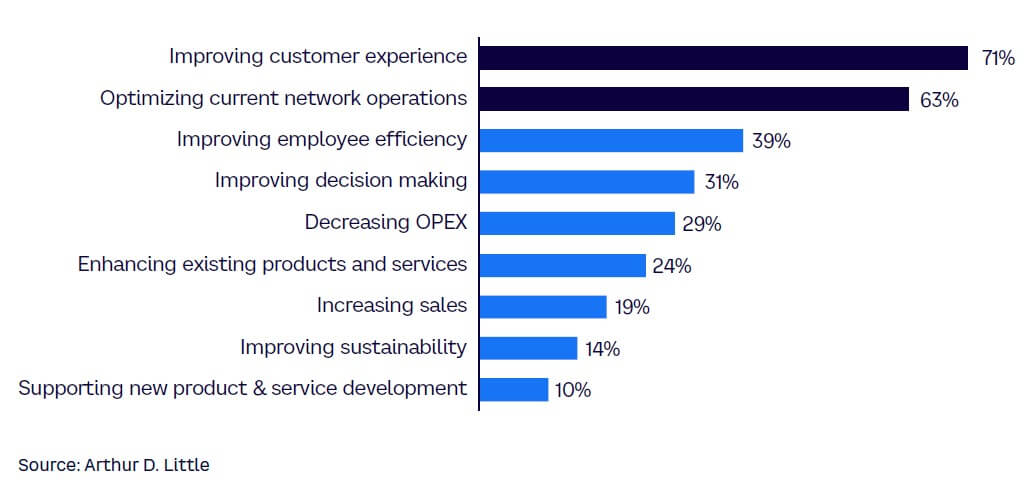
ENHANCING DIGITAL ADOPTION
Many telecom operators worldwide still lag in understanding the significant impact of digital channels on the evolution of channel mix and in understanding the methodologies required to seamlessly apply AI to enable such digital adoption by telecom operators. According to a recent ADL Blue Shift Report based on in-depth research, market experience, an online expert survey, and interviews with leading players, only 16% of the 49 organizations surveyed had large-scale investments in GenAI in 2023; 22% had limited investments in the area, with the rest having no investments or no awareness of any investments within the organization.
Attitudes toward GenAI are also a barrier, as documented in Blue Shift:
-
51% of surveyed experts and organizations had limited familiarity with the subject.
-
18% had strong familiarity with AI use cases within their organization.
-
20% of the surveyed organizations had no familiarity with the technology.
-
4% were aware of technology but refused to implement it.
Efficient utilization of these new technologies and digital formats can yield significant benefits, particularly in three key areas of value:
-
Operational model and cost structure. Digital channels significantly reduce the need to maintain multi-format physical channels, as well as remote call centers and commissions with third parties. Consequently, the investment made would be directly offset by the savings and cost efficiencies produced. For example, ADL analysis shows that 30% more customers can be served by a single agent, and customer response waiting time can be reduced by 20% through a well-developed AI digital channel where customers are greeted by a hybrid AI-agent profile first.
-
CX. AI can enhance engagement and improve CX at every stage of the lifecycle, from initial contact through the sales process and quality assurance to the management of existing customers to reduce churn probability. Our studies show that SMS/email content and visuals adjusted, based on consumer lifestyle/microsegment, generate a 15% higher positive response, increasing the net promoter score (NPS) faster than with traditional mechanisms.
-
Commercial efforts. The availability of richer information and insights can assist in personalizing and adjusting the value proposition, promotions, pricing, and conducting more effective cross-selling and upselling efforts. For example, ADL analysis indicates that a text-to-image model creates custom “apparel” that can be tailored to a “unique” service, resulting in a 40% increase in platform browsing and attention from customers.
The AI revolution has the potential to help telco’s commercial channels evolve from personalized sales to proactive service. Yet bridging the gap between potential and profit requires more than just technical expertise. A strategic roadmap is key to ensuring that the company does not fall behind and successfully implements AI commercial capabilities, as they must become part of daily operational routines. We propose an effective and seamless three-step approach to activate and enhance these capabilities. As we illustrate later in this Viewpoint, this approach focuses first on laying the proper foundations for AI adoption, followed by strategic implementation and development, and ends by optimizing the engine for continuous improvement. By following this roadmap, telcos can transform AI from a futuristic ideal to a potent engine for innovation and commercial success. But first, let’s examine how AI affects the sales process.
HOW AI IMPACTS THE SALES PROCESS
Telcos can effectively use AI end-to-end (E2E) through the entire sales process, as shown in Figure 2. First, telcos can enhance sales productivity, resulting in more lead generation, by leveraging AI-driven insights to effectively target customers. Additionally, telcos can lower unit costs within the sales process by optimizing resource allocation and capabilities. Subsequently, telcos can maximize the value of each sales unit by adopting personalized offerings and pricing strategies. Finally, telcos can enhance CX and satisfaction by automating their follow-ups and resolution processes.
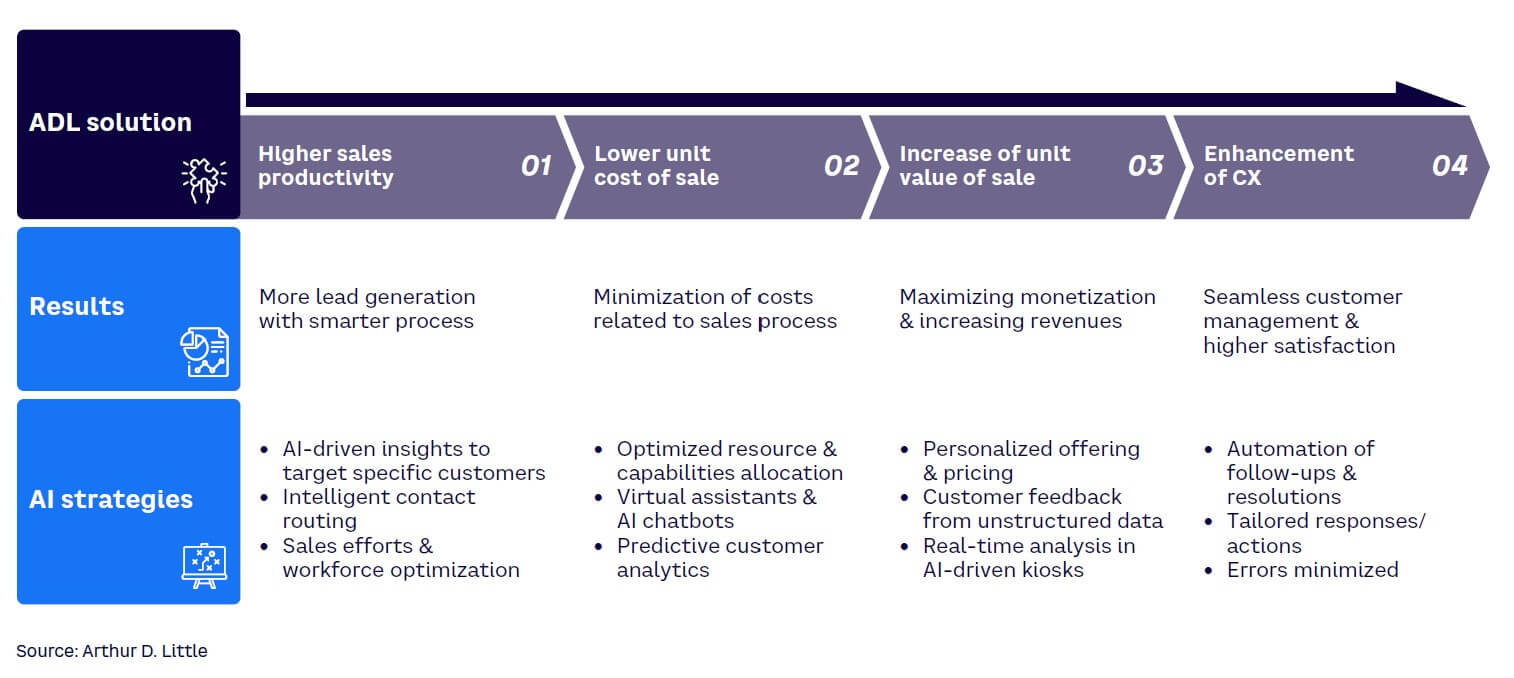
1. Impact of AI on sales productivity
AI is reshaping sales with tools that elevate productivity; its offerings range from visual search for streamlined CX to real-time customer data platforms. These advancements work together, encompassing proactive communications, intelligent contact routing, and emotional detection, aiming to turn every interaction into potential sales through personalized responses.
AI’s strength lies in task automation, interaction personalization, and workforce optimization.
Cases across the telco industry include targeting and lead generation, predictive analytics that empower teams to sift through vast amounts of customer data, and high-potential lead identification that enables focused efforts on the most promising opportunities. Through market segmentation, AI helps tailor sales approaches and messages to different customer groups, ensuring a more personalized and effective engagement strategy. Real-time lead scoring further streamlines the process, allowing sales reps to prioritize and convert leads based on their online behavior and interactions.
GenAI is redefining managerial capabilities by evolving reports into predictive diagnostic tools, enabling swift opportunity identification, and real-time coaching.
This transformative approach replaces custom builds with the adoption of off-the-shelf applications, reducing the need for specialized talent.
In sales process automation and optimization, automated quote generation not only saves time for sales reps but also ensures precision. Moreover, AI facilitates more efficient contract analysis and review, highlighting key terms and potential risks. The integration of AI-powered sales pipeline management tools automates tracking, prioritizes tasks, and provides valuable insights, ultimately optimizing the entire sales workflow and enhancing team productivity.
AI is going beyond efficiency to unlock business-to-business (B2B) sales potential. Indeed, Gartner projects that by 2025, 75% of B2B sales teams will integrate AI-driven selling into their methods. By handling repetitive tasks, AI empowers sales reps to concentrate on strategic endeavors. Real-time insights from AI facilitate faster, data-driven decisions. AI’s comprehensive tools are revolutionizing sales productivity by urging teams to work more intelligently, with the potential for further productivity enhancements.
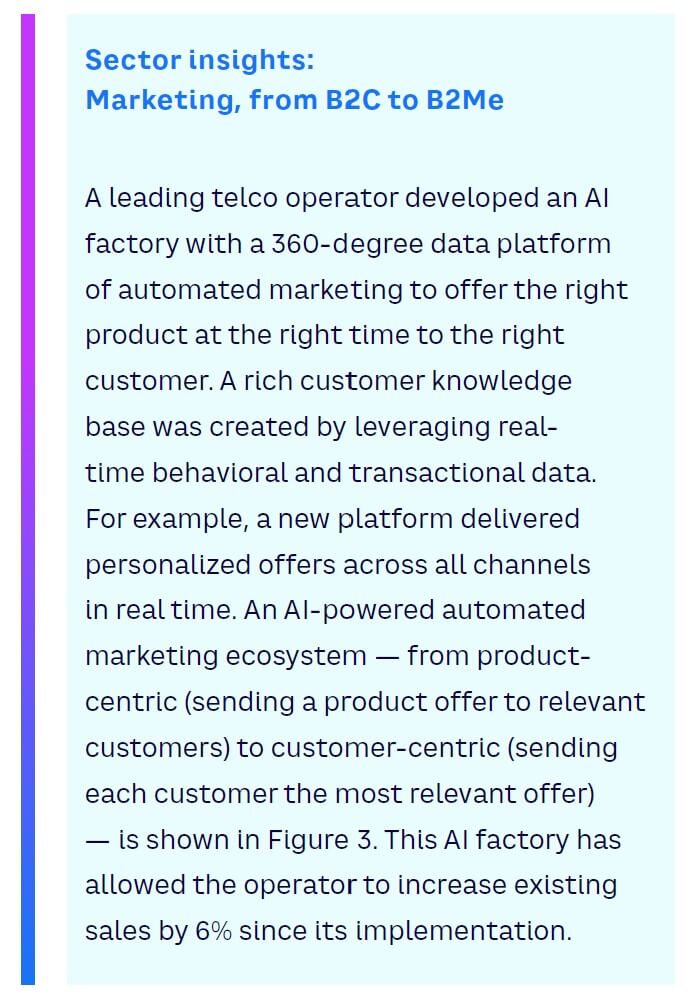
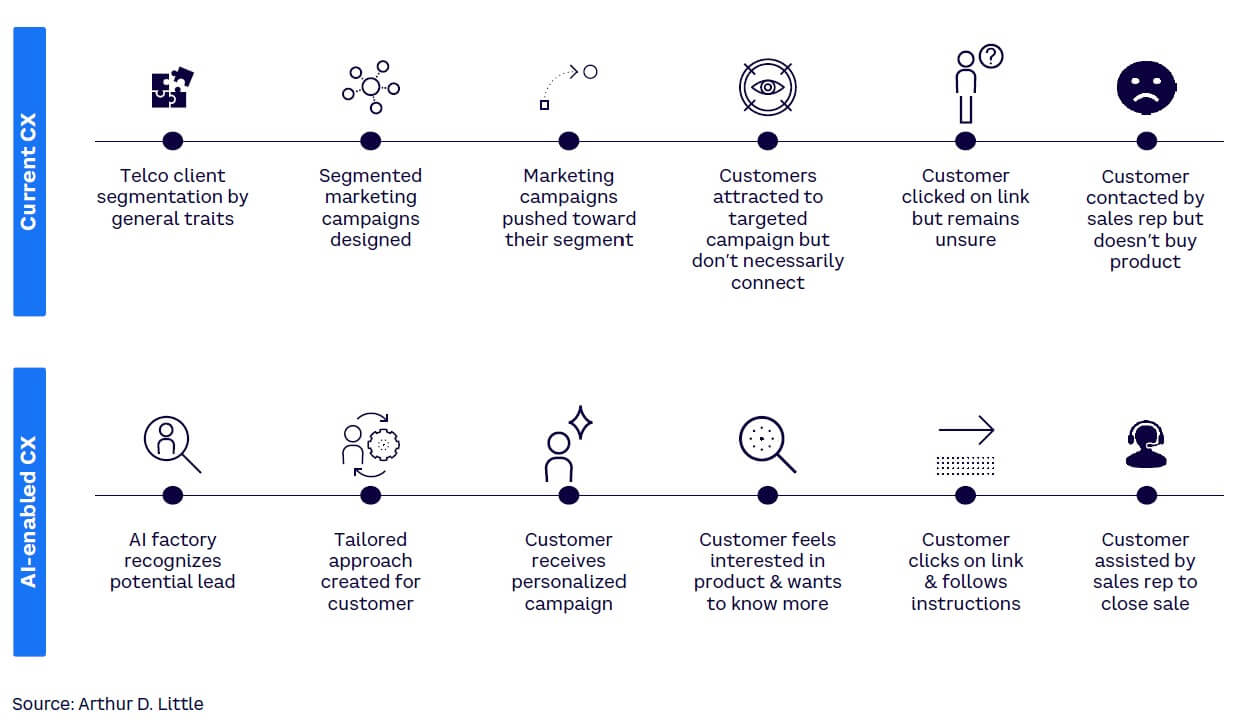
2. Elevating unit value of sales through AI
AI-powered customer analytics and segmentation in telecom companies do more than streamline business operations; they amplify the unit value of sales. By leveraging data-driven insights, CSPs use AI to provide tailored solutions, increasing the likelihood of successful sales closures and upselling. GenAI enhances pricing strategies by rapidly benchmarking products and extracting valuable customer feedback from unstructured data. This facilitates intelligent customer segmentation and pricing approaches, which drive growth and customer satisfaction. Additionally, in B2B environments, AI’s swift identification of key contract clauses supports the creation of competitive offers that contribute to revenue enhancement.

3. Reducing unit cost of sale with AI
AI is dynamically transforming the sales function. The adoption of AI is expected to potentially generate a spike in leads, while significantly reducing call time and costs. By automating forecasting and honing high-quality lead targeting, AI ensures efficient time and resource investment, slashing both labor and miscellaneous costs.
Virtual assistants and AI-driven chatbots are revolutionizing customer support by delivering personalized experiences and automating routine tasks, freeing up human resources for more complex issues. AI-powered chatbots enhance CX and reduce costs by swiftly providing tailored information. They facilitate seamless handoffs to human agents, who are equipped with data acquired by the chatbot when needed. These elements expedite interactions, resulting in significant time and operational cost savings.
AI’s potential in commercial applications isn’t restricted to applications that directly interact with the customer; it also ventures into dynamic price optimization, adjusting prices in real time to address market changes and integrate competitor data.
Internally, AI-powered management tools maximize human resource allocation; when paired with predictive customer analytics, the tools can anticipate needs and streamline operations. Additionally, AI’s predictive capabilities extend to managing energy consumption across networks, serving as a preemptive factor in network planning, deployment, and operations.
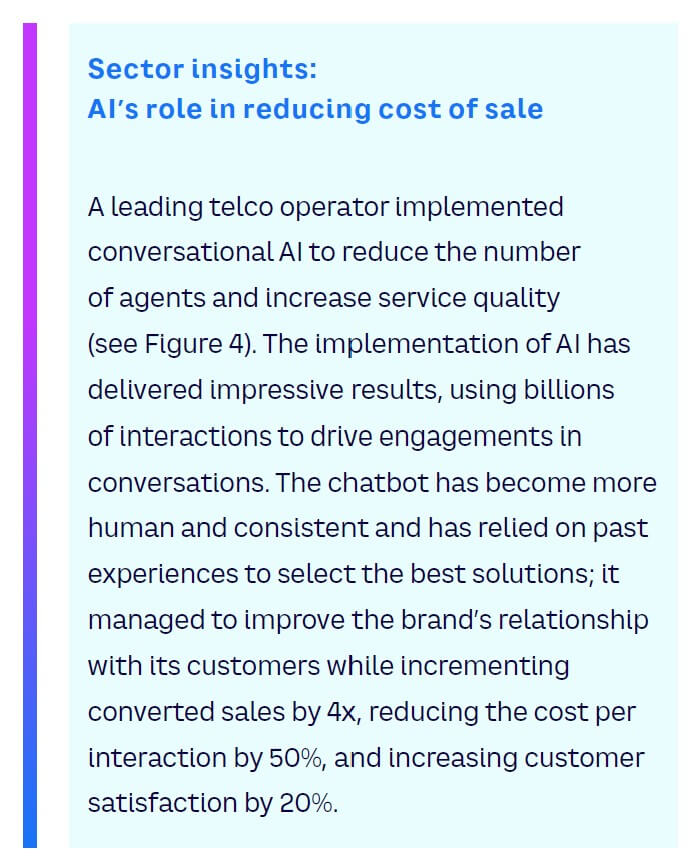

4. AI enhancement of customer management & experience
AI plays a pivotal role in refining customer follow-up and responses, which significantly benefits sales executives. By automating lead nurturing campaigns, it enhances efficiency by introducing new offerings to existing clients and managing requests, complaints, and suggestions (RCS), thus freeing up executives to focus on critical tasks such as closing deals. Its unique capability lies in crafting personalized follow-up messages and responses, thereby increasing conversion prospects, providing efficient RCS solutions, and ultimately leading to higher customer satisfaction. By leveraging historical data, AI determines optimal times for follow-ups, ensuring timely and relevant interactions.
Moreover, it recommends tailored solution response actions, minimizes errors, and continually monitors effectiveness for strategic enhancements.
AI’s impact extends further through complete automation of the follow-up and response process, autonomously dispatching personalized messages at precisely the right time without requiring human oversight. This timely and targeted communications significantly amplify the interaction outcomes, keeping customers engaged at crucial moments. Furthermore, this autonomy enhances conversion chances and empowers sales executives to engage in complex negotiations and cultivate relationships more effectively. Additionally, AI provides comprehensive records of these interactions, capturing their success metrics for future reference and analysis.
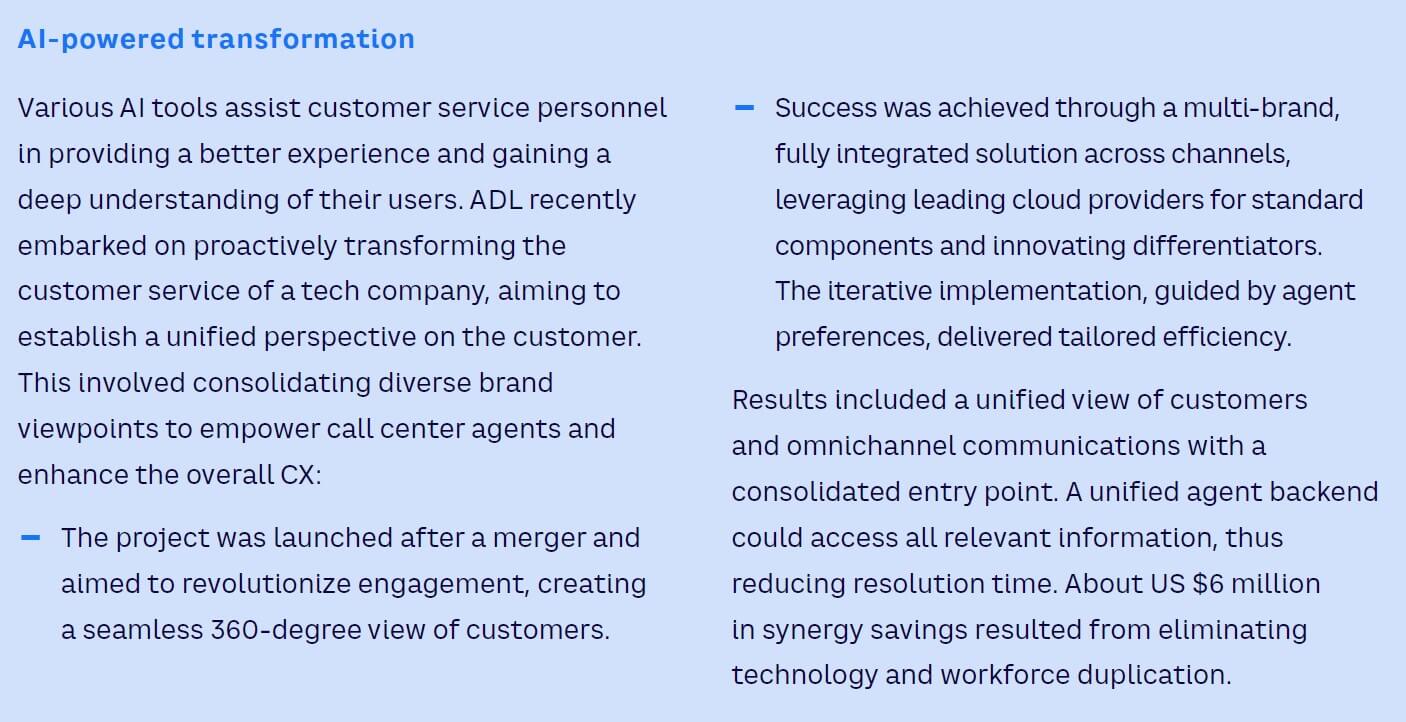
ACTIVATING COMMERCIAL CAPABILITIES THROUGH AI
As the wave of AI continues, several pivotal concerns emerge that businesses must address to harness its full potential. rom governance structures to the nuances of use case selection and the ever-present need for data security, a comprehensive three-step roadmap (see Figure 5) can guide leaders through their AI journey of integrating its capabilities into their day-to-day processes.

1. Setting the scene
-
Goals definition. Clearly articulate desired outcomes for implementing AI. Identify specific business challenges to address and the value to unlock. A roadmap with well-defined goals guides the journey and ensures every step contributes to their achievement.
-
Governance and sponsorship. Establish a clear ownership structure, whether centralized or decentralized, and designate a dedicated senior sponsor to drive decision-making and accountability aligned with the goals.
-
Data integrity and infrastructure. Secure high-quality data, cultivate robust underlying processes and systems, and prioritize data security as the foundation for reliable and trustworthy AI outcomes that support the process of achieving goals.
-
Demystifying AI. Bridge the knowledge gap by educating leadership on key AI concepts and equip the team with relevant AI tools to minimize bias and promote informed decision-making, enabling effective implementation and utilization of AI solutions.
2. Charting the course
-
Maturity assessment. Conduct a comprehensive evaluation of the organization’s AI readiness, identifying strengths and weaknesses to develop a roadmap for skill and infrastructure development.
-
Use case prioritization. Meticulously analyze potential AI applications, quantify their impact, and prioritize high-value initiatives to maximize ROI and steer resources toward projects with the greatest potential.
-
“Lighthouse” projects. Implement strategically chosen pilot projects, using minimum viable products as controlled experiments to gather valuable data, refine approaches, and ensure success before full-scale deployments.
3. Optimizing for success
-
Alignment and measurement. Identify KPIs for each AI application to ensure alignment with overall strategic objectives and enable measurable results.
-
Continuous improvement. Foster a culture of iterative learning by regularly evaluating the business impact of deployed AI solutions, adapting approaches based on data insights, and actively seeking new optimization opportunities.
-
Internal expertise development. Invest in comprehensive training programs for the workforce on AI tools and methodologies to cultivate in-house expertise and empower teams to drive future innovation and success.
NAVIGATING THE NEXT DECADE
The landscape for customer engagement within the telecom sector continues to be ripe for innovation, with enterprise service management tools playing a pivotal role. An in-depth ADL analysis unveiled AI as the torchbearer leading the charge toward a more personalized, insightful, and efficient future:
-
Hyperpersonalization in marketing. The power of GenAI is being harnessed to revolutionize marketing and sales strategies. Telcos are now poised to see a 3%-7% revenue increase through AI’s capability to tailor social media and advertising messages, creating a more personalized dialogue with customers.
-
The “segment of one.” The traditional one-size-fits-all approach to campaign management is giving way to a “customer segment of one,” with potential revenue boosts of 2%-6%. This hyperpersonalized strategy digs deep into consumer behaviors, enabling telcos to focus their communications and offerings on individual preferences and behaviors.
-
AI-powered churn reduction. Churn management is transitioning from reactive to predictive, with AI using vast data sets, including location and browsing history, to anticipate and address churn proactively. This could lead to a 2%-5% reduction in churn rates.
-
Redefining sales and channel partnerships. In sales and market planning, AI and data-driven strategies are recalibrating the dynamics between telcos and their channel partners. It’s no longer just about managing partners, but empowering them with AI-crafted content to fuel their sales, projecting revenue increases of 2%-6%.
-
Loyalty in the AI era. Lastly, loyalty and referral programs are being reimagined through AI’s lens. Personalization goes beyond basic point systems to create dynamic loyalty programs that could enhance customer retention by 2%-5%.
As we push toward 2030, it’s clear that AI’s role in marketing, sales, and loyalty programs will not just support the existing infrastructure, it will redefine it. The technology’s current trajectory promises a future where each customer interaction is an opportunity for telcos to consolidate their relationships, drive revenue, and reduce costs, all while delivering an unmatched CX. The onus is now on these companies to strategically invest and integrate these AI advancements to remain at the forefront of this customer engagement revolution.
Conclusion
BOOSTING SALES EFFICIENCY & CUSTOMER SATISFACTION
Telcos that proactively integrate AI into their daily operations can achieve significant improvements in sales efficiency and customer satisfaction. Embracing these advancements is essential for maintaining a competitive edge, maximizing operational efficiency, and enhancing customer interactions, which will create substantial value:
-
Refining sales strategies and follow-up processes. AI optimizes the unit value of each transaction, ensuring tailored and value-added engagements.
-
Advanced automation. AI enables professionals to focus on more intricate tasks, fostering stronger relationships and improving conversion chances.
-
E2E impact. When used proactively in daily operations with an E2E approach, AI can positively impact all areas and processes.
-
Competitive edge and operational efficiency. Embracing AI is crucial for businesses to maintain a competitive edge, maximize operational efficiency, and elevate customer interactions.


